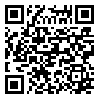Volume 3, Issue 3 (2018)
Manage Strat Health Syst 2018, 3(3): 225-239 |
Back to browse issues page
MSc student in Healthcare Management, Health Policy and Management Research Center, School of Public Health, Shahid Sadoughi University of Medical Sciences, Yazd, Iran
Abstract: (2994 Views)
Background: The benefits of health services are affected by several factors. The possible consequences of such factors affect the utilization rate of health services and may lead to higher costs of health care induced by the increased use of medical care services. Therefore, this study was conducted to investigate the effect of patient-related factors on the utilization rate of health services among the selected hospitals of Qom city in 2017.
Methods: The present cross-sectional descriptive-analytic study was carried out in 2017. Data were collected using Goldberg standard health questionnaire and a checklist completed by 400 patients who referred to the selected hospitals of Qom city. Data were analyzed by Stata 13 and the logistic regression test was run to determine the effect of independent variables (effective factors on the use of services) on the dependent variable (service usage). Later, we analyzed results of the regression tests and investigated the relationship of the independent factors and the demographic information on the use of services.
Results: The results of logistic regression tests showed the utilization rate of services by investigating the relationship among demographic, independent, and dependent variables. We found that utilization rate of health services increased by the following factors: older age, female gender, higher number of family members, higher family income, higher education level of the head of household, higher education level of patients, and residence in urban areas of Qom city. Further factors included being native of the city, being under the basic and supplementary insurance coverage, and having poor health status. Moreover, married head of family, employment of family members in the medical care system, near distance to the hospital, and more leaves from work led to more application of services. In addition, patients who spent more days to take the doctor's visit, spent more time in the clinic to visit the doctor, and had longer visit duration by the physician used the services more frequently. Furthermore, utilization rate of services had a statistically significant relationship with the health status of the individual, the marital status of the family head, and the visit duration by the physician.
Conclusion: Considering the effective factors on utilization rate of services by patients, health system administrators can analyze the risk factors and make practical suggestions to control and reduce the false use of services by patients and physicians. In this regard, they can implement incentive and punitive mechanisms, create awareness among people about the challenges and risks of the induced demand, change the strategies, modify the insurance payments, rate the level of services for different classes of the society, and maintain the financial resources to meet the needs.
Methods: The present cross-sectional descriptive-analytic study was carried out in 2017. Data were collected using Goldberg standard health questionnaire and a checklist completed by 400 patients who referred to the selected hospitals of Qom city. Data were analyzed by Stata 13 and the logistic regression test was run to determine the effect of independent variables (effective factors on the use of services) on the dependent variable (service usage). Later, we analyzed results of the regression tests and investigated the relationship of the independent factors and the demographic information on the use of services.
Results: The results of logistic regression tests showed the utilization rate of services by investigating the relationship among demographic, independent, and dependent variables. We found that utilization rate of health services increased by the following factors: older age, female gender, higher number of family members, higher family income, higher education level of the head of household, higher education level of patients, and residence in urban areas of Qom city. Further factors included being native of the city, being under the basic and supplementary insurance coverage, and having poor health status. Moreover, married head of family, employment of family members in the medical care system, near distance to the hospital, and more leaves from work led to more application of services. In addition, patients who spent more days to take the doctor's visit, spent more time in the clinic to visit the doctor, and had longer visit duration by the physician used the services more frequently. Furthermore, utilization rate of services had a statistically significant relationship with the health status of the individual, the marital status of the family head, and the visit duration by the physician.
Conclusion: Considering the effective factors on utilization rate of services by patients, health system administrators can analyze the risk factors and make practical suggestions to control and reduce the false use of services by patients and physicians. In this regard, they can implement incentive and punitive mechanisms, create awareness among people about the challenges and risks of the induced demand, change the strategies, modify the insurance payments, rate the level of services for different classes of the society, and maintain the financial resources to meet the needs.
| Rights and permissions | |
 |
This work is licensed under a Creative Commons Attribution-NonCommercial 4.0 International License. |





